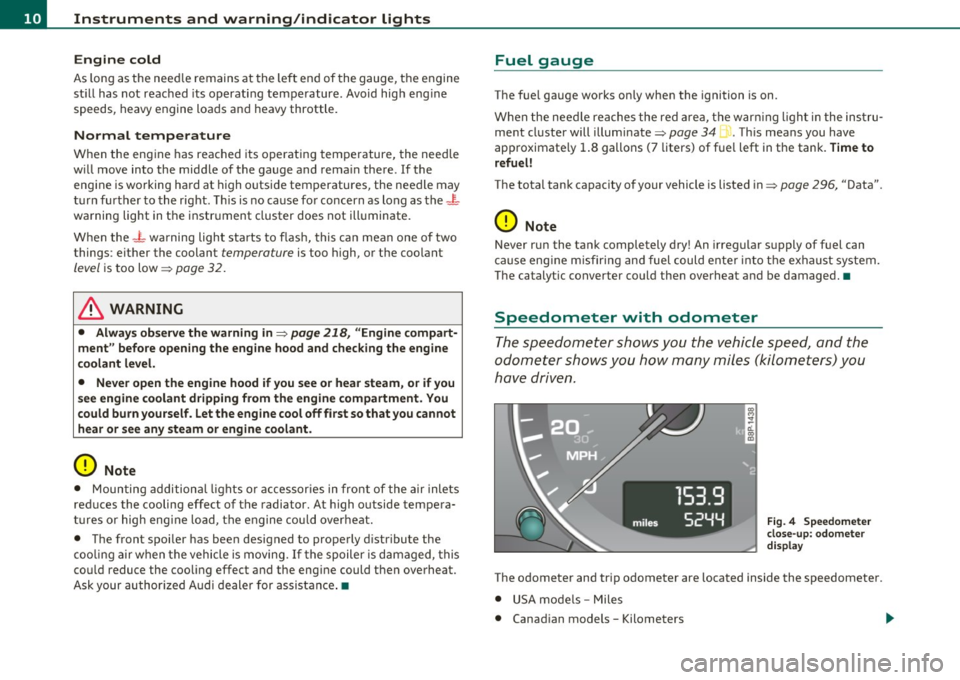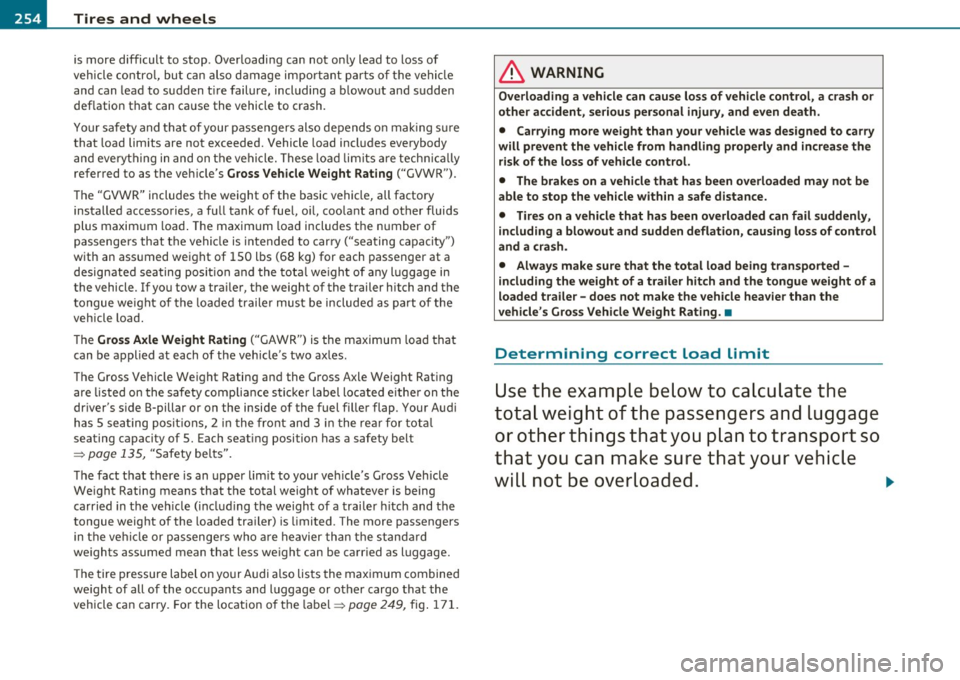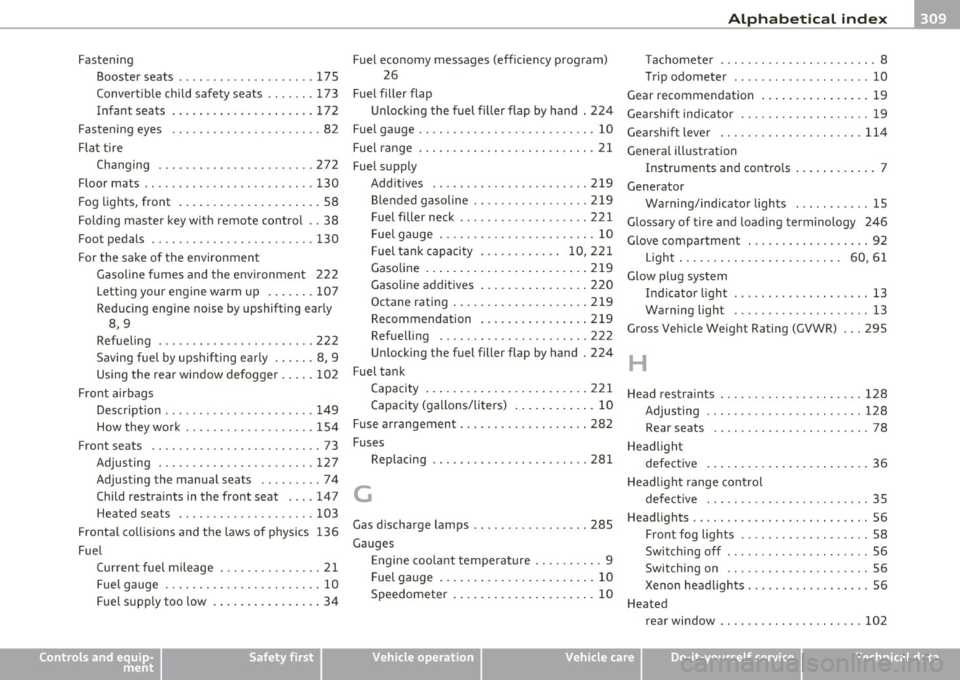coolant capacity AUDI A3 2011 Owner´s Manual
[x] Cancel search | Manufacturer: AUDI, Model Year: 2011, Model line: A3, Model: AUDI A3 2011Pages: 320, PDF Size: 75.79 MB
Page 12 of 320

Instruments and warning/indicator lights
Engine cold
As long as the need le remains at the lef t en d of the gauge, the engine
s till has not reac hed its operati ng te mperature . Avoid hig h eng ine
speeds, heavy engine loads a nd heavy throttle.
Normal temperature
W hen the eng ine has reached its operating temperature, the need le
w ill move into the middle of the gauge and rema in there . If the
engine is working ha rd at high outsi de temperatures, the needle may
tur n further to the rig ht. Thi s is no cause fo r concern as long as the _F_
wa rning light in the i nstr ument cluster does not ill uminate.
Wh en the _;_ w ar ning light sta rts to fla sh, thi s can mea n one of two
things : either the coolant
temperature is too h igh, or t he coolant
level is too low => page 32.
& WARNING
• Always observe the warning in=> page 218, "Engine com part·
ment " before opening the engine hood and checking the engine
c oolant level.
• Never open the engine hood if you see or hear steam, or if you
see engine coolant dripping from the engine compartment. You
could burn yourself. Let the engine cool off first so that you cannot
hear or see any steam or engine coolant.
0 Note
• Moun ting addition al lights or accessorie s in fron t of the a ir inlets
red uces the cooling effect of the radiator. At high o utside tempera
tu res o r high eng ine lo ad, t he e ngine cou ld over heat .
• The front spoi ler has been designed to prope rly d istribute the
c oo ling a ir w hen the vehicle is moving. If the spoiler is d amaged, this
co uld reduce the coo ling effect and the eng ine could t hen overheat.
Ask your au thor ized A udi d ealer for assist ance .•
Fuel gauge
T he f uel gauge wo rks only whe n the ignition is on.
W hen the nee dle rea ches the red area, t he war ning ligh t in t he ins tru
ment cl uster will illum inate=>
page 34 . This mea ns you have
app roximate ly 1.8 gallons (7 liters) of f uel left in t he tank.
Time to
refuel!
The tota l tan k capacity of your vehicle is listed in => page 296 , "Data".
0 Note
Never run the ta nk completely d ry ! An irregular s upply of f uel can
c a us e eng ine mi sfir ing and f uel could ente r into t he e xhaus t system.
T he catalyt ic converter could the n overheat a nd be damaged. •
Speedometer with odometer
The spee do meter sh o ws you the ve h icle s pee d, an d th e
o do met er sho ws yo u ho w many mile s (k il om eters) you
have d riv en .
Fig. 4 Spee dometer
close-up : odometer
di splay
The o dometer and tri p odometer are located inside the speedomete r.
• USA mo dels - Mile s
• Canad ian models -Kilometers
Page 256 of 320

_L_T.:...:..: i r~ e:.: s~ a:::. n:..:..:: d:.....: w..:...:. h::e:.: e::.:: ls::::._ ______________________________________________ _
is more difficult to stop. Overloading can not only lead to loss of
vehicle control, but can also damage important parts of the vehicle
and can lead to sudden tire failure, including a blowout and sudden
deflation that can cause the vehicle to crash.
Your safety and that of your passengers also depends o n making sure
that load limits are not exceeded. Vehicle load includes everybody
and everything in and on the vehicle. These load limits are techn ically
referred to as the veh icle's
Gross Vehicle Weight Rating ("GVWR").
Th e "GVWR" includes the weight of the basic vehicle, all factory
installed accessories, a full tank of fuel, o il, coolant and other fluids
plus maximum load. The maximum load includes the number of
passenge rs that the vehicle is intended to carry ("seating capacity")
with an assumed weight of 150 lbs (68 kg) for each passenger at a
designated seating posit ion and the total weight of any luggage in
the vehicle. If you tow a trailer, the weight of the trailer hitch and the
tongue weight of the loaded trailer must be included as part of the
vehicle load.
T he Gross Axle Weight Rating ("GAWR") is the maximum load that
can be applied at each of the vehicle's two ax les.
The Gross Vehicle We ight Rating and the Gross Axle Weight Rat ing
are listed on the safety compliance sticker label located e ithe r on the
dr iver's s ide B-pillar or on the inside of the fuel filler flap. Your Audi
has 5 seating positions, 2 in the front and 3 in t he rear for total
seating capacity of 5. Each seating position has a safety belt
=> page 135, "Safety belts".
The fact that there is an upper limit to your veh icle's Gross Veh icle
Weight Rating means that the total weight of whatever is being
carried in the veh icle (in cluding the weight of a trailer hitch and the
tongue weight of the loaded trailer) is limited . The more passengers
in the vehicle or passengers who are heavier than the standard
we ights assumed mean that less we ight can be carr ied as luggage.
Th e tire pressure label on your A udi also lists the maximum combined
we ight of all of the occupants and luggage or other cargo that the
vehicle can carry. For the location of the labe l=>
page 249, fig. 171.
& WARNING
Overloading a vehicle can cause loss of vehicle control, a crash or
other accident, serious personal injury, and even death.
• Carrying more weight than your vehicle was designed to carry
will prevent the vehicle from handling properly and increase the
risk of the loss of vehicle control.
• The brakes on a vehicle that has been overloaded may not be
able to stop the vehicle within a safe distance.
• Tires on a vehicle that has been overloaded can fail suddenly,
including a blowout and sudden deflation, causing loss of control
and a crash.
• Always make sure that the total load being transported -
including the weight of a trailer hitch and the tongue weight of a
loaded trailer -does not make the vehicle heavier than the
vehicle's Gross Vehicle Weight Rating .•
Determining correct load limit
Use the example below to calculate the
total weight of the passengers and luggage
or other things that you plan to transport so
that you can make sure that your vehicle
will not be overloaded. ._
Page 311 of 320

___________________________________________ A_ l:.. p _h _a_ b_ e_t _ic _a_ l_ in_ d _ e_x __ _
Fastening
Booster seats ............... ... .. 17
5
Convert ible child safety seats .. ..... 173
Infant seats ..................... 172
Fastening eyes . ................. .. .. 82
Flat tire Changing . .. ........... .. .... .. . 272
Floor mats ........... .... .......... 130
Fog lights, front ........... .... .. .. .. 58
Folding master key with remote control .. 38
Foot pedals .. .. ... ........ .. .... .. . 130
For the sake of the environment
Gasoline fumes and the environment 222
Letting your engine warm up ....... 107
Reducing engine noise by upshifting ear ly
8,9
Refueling . .. .. .. .. .. .. .. ........ 222
Saving fuel by upshifting early .. ... . 8, 9
Using the rear window defogger . ... . 102
Front airbags Description . ...... .. .. .. .. .. .... . 149
How they work .......... .. .. .. .. . 154
Front seats .. .. .. ................... 73
Adjusting . .. ... ........ ...... .. . 127
Adjusting the manual seats ......... 74
Child restraints in the front seat .... 147
Heated seats .................... 103
Fro ntal collisions and the laws of physics 136
Fuel Current fuel mileage .... .... ....... 21
Fu el gauge ........ ... .. ...... .. .. 10
Fuel supply too low . ... .. .. .... .... 34
Controls and equip
ment Safety first
Fuel
economy messages (efficiency program)
26
Fuel filler flap Unlocking the fuel filler flap by hand . 224
Fuel gauge .... .. ................. ... 10
Fuel range ............. .... .. .. .. .. . 21
Fuel supply
Additives .. ............... ...... 219
Blended gasoline .... .. .. .. ... .... 219
Fuel filler neck .. ........... .. .. .. 221
Fuel gauge . .... .... .. .. ... ....... 10
Fuel tank capacity ......... ... 10,221
Gasoline ...................... .. 219
Gasoline additives ................ 220
Octane rating ...... .............. 219
Recommendation ................ 219
Refuelling ... .. .... .. .. .... .. ...
222
Unlocking the fuel filler flap by hand . 224
Fuel tank
Capac ity ........................ 221
Capacity (gallons/liters) ........ ... . 10
Fuse arrangement ................ ... 282
Fuses Replacing ....................... 281
G
Gas discharge lamps ...... ........... 285
Gauges Eng ine coolant tern perature .......... 9
Fuel gauge .. ..... .. .............. 10
Speedometer ............ .. ... .... 10 Tachomete
r ... ... .... ........ ..... 8
Trip odometer .................... 10
Gear recommendation ................ 19
Gearshift indicator ................... 19
Gearshift lever .................... . 114
General illust ration
Instruments and controls ............
7
Generator
Warning/indicator lights ... .. ...... 15
Glossary of tire and loading terminology 246
Glove compartment . .. .. .. ...... ..... 92
Light . . . . . . . . . . . . . . . . . . . . . . . . 60, 61
Glow plug system Indicator light .................... 13
Warning light ...... ..... ... . ... .. 13
Gross Vehicle Weight Rating (GVWR) ... 295
H
Head restraints .......... .... .. .. .. . 128
Adjusting ................. ...... 128
Rear seats .. .. ................... 78
Headlight defective ... ...... ............... 36
Headlight range control defect ive . .. ...... ............... 35
Headlights ................. ... ...... 56
Front fog lights ................... 58
Switching off ... ..... .... ... .. .. .. 56
Switching on ................... .. 56
Xenon headlights . .. .... .... .. ..... 56
Heated rear window ..................... 102
Vehicle operation Vehicle care Do-it-yourself service Technical data